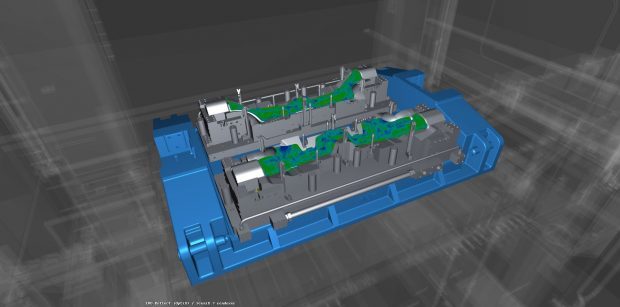
ESI Group’s PAM-STAMP provides capabilities for sheet metal stamp simulation from style to design and from part to die production. Shown here is a part after quenching. AP&T image courtesy of the ESI Group.
Latest News
May 2, 2018
 Dear DE Reader:
Dear DE Reader:
If your first thought reading the words “PAM-STAMP simulation software” is that it concerns designing body art, please move on to your next email. The ESI Group’s PAM-STAMP is a widely respected and widely deployed body of die face design and sheet metal forming simulation tools. ESI recently introduced PAM-STAMP 2018. Here’s why it gets today’s Editor’s Pick of the Week ink.
Backgrounder: PAM-STAMP comprises an integrated and scalable suite of sheet metal-forming simulation applications. It’s at home in most any metal forming industry like automotive, aerospace, electronics and appliance manufacturing.
With it, engineers design, test and optimize most metal forming processes. Tube forming, cold or hot sheet metal or whatever process are within its purview. It handles die surface design and feasibility, formability, material cost estimation, part design validation and tryout validation. You can review a part’s final quality in virtual reality.

ESI Group’s PAM-STAMP provides capabilities for sheet metal stamp simulation from style to design and from part to die production. Shown here is a part after quenching. AP&T image courtesy of the ESI Group.
Efficiency and clarity seem to be the watchwords for PAM-STAMP 2018. An example of both for automotive OEMs (original equipment manufacturers) is that it enables a complete virtual tryout. So, not only can you make certain that the final assembled component is within tolerances, but you can manage individual parts as well as the full assembly process for doors and closures. This should help stamp out those last few uncertainties before you move on to physical tryouts.
With this release, PAM-STAMP debuts a method that couples real-time stamping and tool deformation simulations. What this does is replicate the changes in tool shapes during the forming process, which should help improve springback prediction accuracy and cosmetic defects analyses.
PAM-STAMP 2018 also offers a material characterization wizard for working with advanced material models. Material parameters are obtained from standard uni-axial tensile test data automatically.
As for scalability plus efficiency, PAM-STAMP 2018 sees improved sheet metal forming solvers for HPC (high-performance computing) installations. ESI reports that scalability is now available for up to 128 cores. ESI says that means you could obtain at least two iterations of a high-quality forming simulation of large panels in a workday.
PAM-STAMP 2018 has a ton of capabilities that should make the design and execution of sheet metal forming processes more accurate and more efficient. You can learn more about it from today’s Editor’s Pick of the Week write-up. Hit the link to the dedicated PAM-STAMP web page at the end of the main content to access 20 additional links that cover all its potential.
Thanks, Pal. – Lockwood
Anthony J. Lockwood
Editor at Large, DE
More ESI Coverage
Subscribe to our FREE magazine, FREE email newsletters or both!
Latest News
About the Author
Anthony J. Lockwood is Digital Engineering’s founding editor. He is now retired. Contact him via [email protected].
Follow DE





